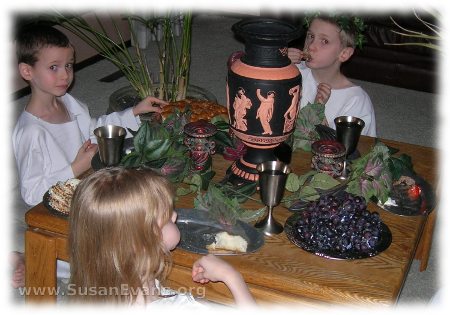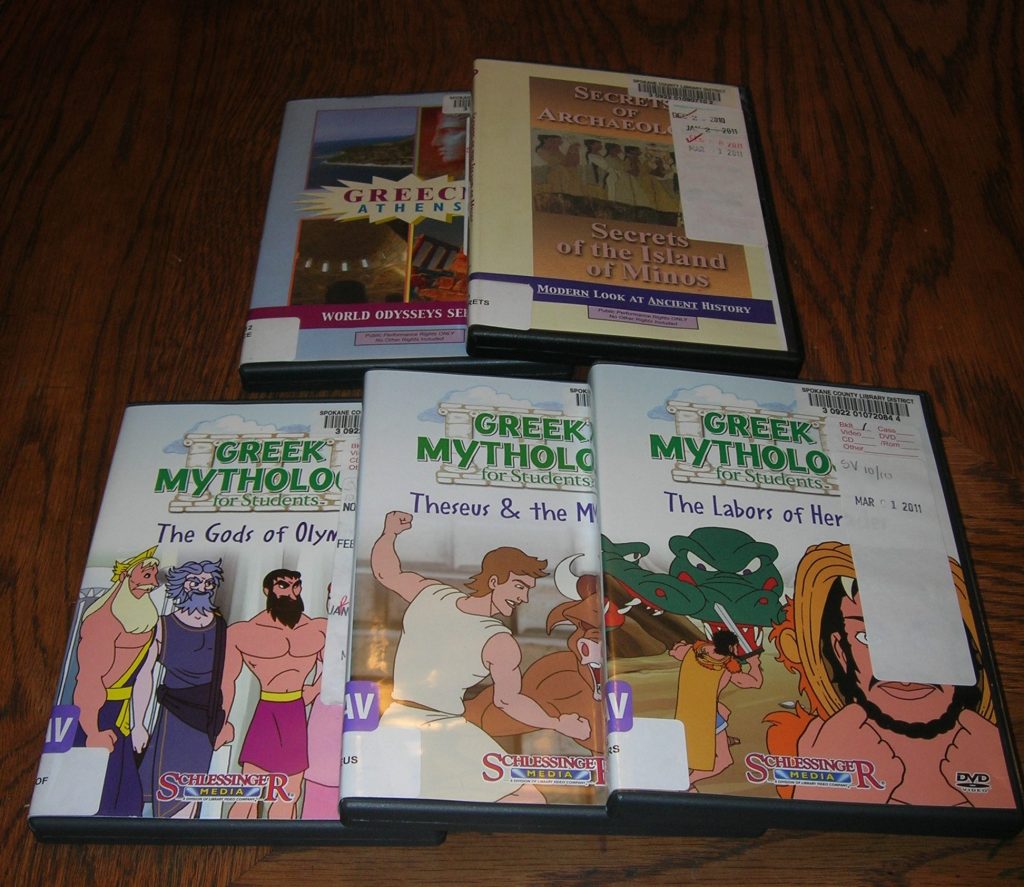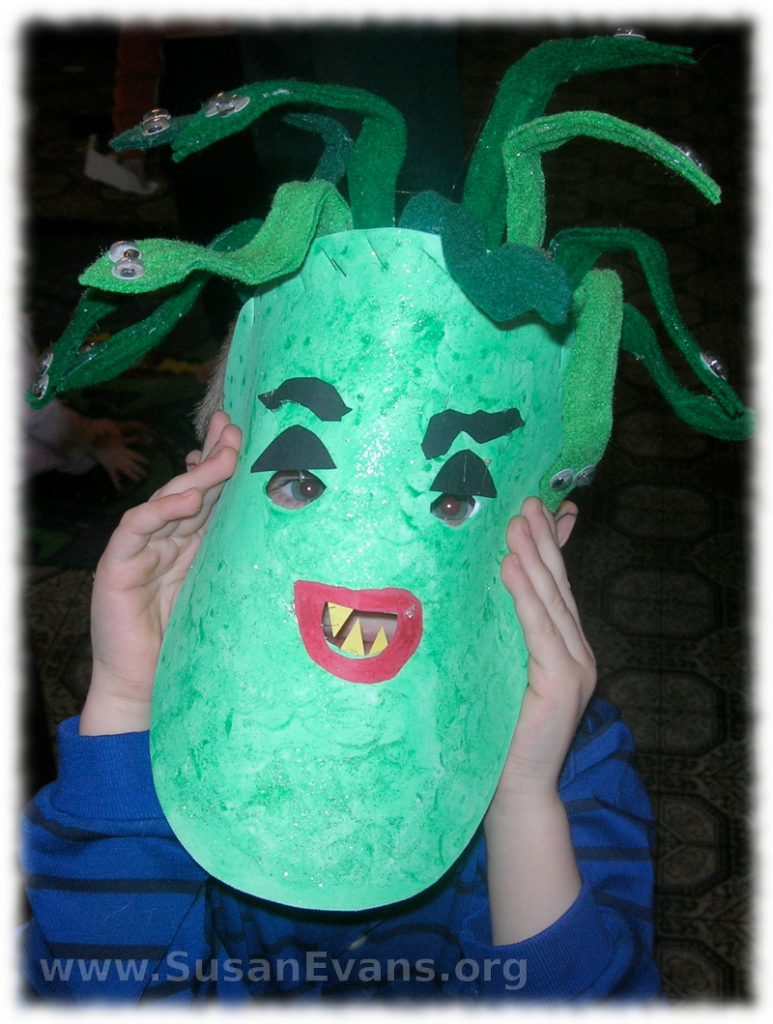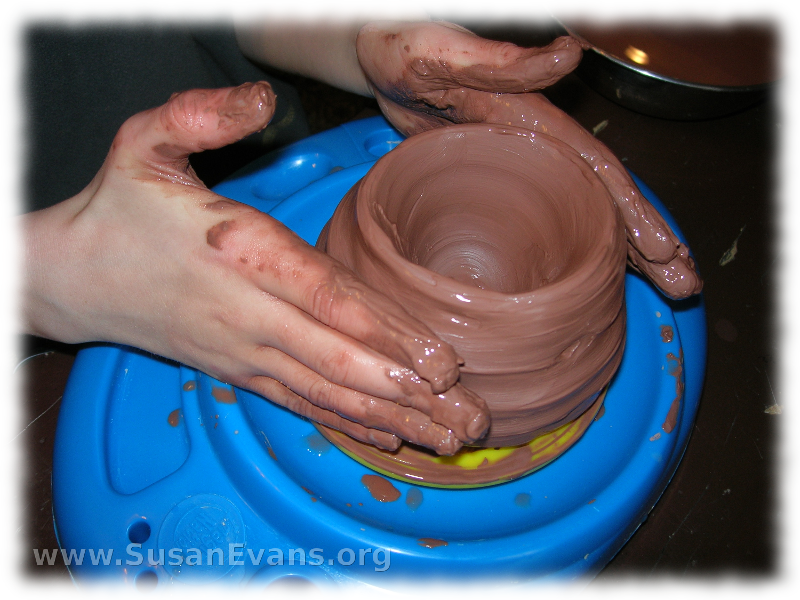The Greek Feast was the culminating activity for our Ancient Greece Unit Study. Here is the video footage of my children eating Greek food, dancing clumsily, and going out to get some baklava.
Archive for the ‘History’ Category
Greek Feast
Wednesday, March 16th, 2011Ancient Greece Videos for Kids
Monday, February 28th, 2011Videos are often helpful to understand history, geography, or literature. All three subjects are covered in the following Ancient Greece videos for kids. I would watch these videos with your children, so that you can comment. For example, if a cartoon Greek hero is praying to a god or goddess, I point out that it’s sin, because we’re only supposed to pray to God. I also point out that these are just make believe gods. Children know the difference between truth and fiction if you teach them about it. With that said, I found the following videos at the library:
“Greece, Athens” by World Odysseys Series gets a hesitant thumbs up from me. I always like to start with a video that shows you the country you are studying, so that you can get your bearings. The views of Athens were breathtaking, and they reminded me of my trip to Athens and the Greek islands. (Back when I was single and was a student in England, I traveled the world during my free time. I got really cheap rates for being a student.) My 10-year-old son was mentally engaged and made various comments about what was being said. It was a documentary, and for this reason, my 9-year-old active son was bored half out of his mind. He briefly perked up when an underground cave was being explored. His eyes were glued to the TV for that brief scene. My 7-year-old son kept slipping down on the couch, just for something to do. And, of course, the sculptures included nudity, but it wasn’t bad. It was mostly male nudity, as my 5-year-old girl pointed out when she yelled, “It’s a wee wee!” So, taken in its totality, the video gets a hesitant thumbs up from me. If the kids hadn’t been there, I would have enjoyed the video more. Let’s put it that way.
“Greek Mythology for Students” is a cartoon series. I love it! I’ve only watched three so far out of the ten. A man walks up and narrates for about two minutes. Then an animated video shows the greatest stories of Greek mythology, making all these stories accessible and understandable even to my 5-year-old. Later on, my husband was lying on the bed, telling my daughter that he had a splitting headache. She shouted, “It’s just like Zeus, whose head cracked open, and Athena came out!” I’m not sure if my husband was impressed or not, but I sure was.
“Secrets of the Island of Minos” The labyrinth of King Minos was shown not only in real life (the ruins that are on the island of Crete), but in a computer animated cartoon that shows what the palace would have looked like on top of the labyrinth. Apparently the palace was like a city, and under it was the labyrinth. I’ve actually been to Crete myself, and the beautiful red columns and fresco paintings on the walls are marvelous. During the first half of the video, my boys paid attention and my 5-year-old girl fidgeted slightly. A couple of drawings had slight nudity which wasn’t offensive. However, later in the half-hour video, there were female sculptures which were, I’m sorry to say, offensive because they were highly evocative. I give a strong thumbs up to the first half of the video, and a strong thumbs down to the second half. The reason I’m giving the video a thumbs up at all is because the first half was so fascinating, it was worth watching. Right in the middle of the video is a 5 minute section on Santorini which is extremely boring. This is ridiculous because I’ve been to Santorini, and it’s beautiful. Anyway, as soon as you get to the boring bit in the middle about Santorini, shut it off. Oh, they also mentioned the lost city of Atlantis, but it was such a brief statement that it left me wanting more. I was dissatisfied about the amount of information about Atlantis.
That’s it for now. I know there are many more Ancient Greece videos for kids about the Trojan War, but I will have to pre-watch those with my husband. Maybe I’ll wait until high school for those.
Why Study Greek Mythology?
Friday, February 25th, 2011Learning Greek mythology is part of having a well-rounded education. Many great works of literature (including Shakespeare) refer back to Greek mythology, and there is no way to properly understand what the greatest authors of all time were saying without knowing about this topic. When literature refers to another famous work of literature, this is called an allusion, and allusions abound in great literature, not only in books and plays, but in poetry as well. This is because the great authors assumed that people who were reading their literature were educated. The basic building blocks of literature that the great books refer to the most are the Bible and Greek mythology.
I used to tell my public school students that even if they didn’t believe in God, they needed to know about the famous classic stories in the Bible, like the story of David and Goliath or Adam and Eve. I told them they would never be truly educated without knowing the Bible because the greatest thinkers of all time knew it, even if they were refuting it. I am not insinuating that the truth in the Bible is in any way comparable to the absurdity of Greek myths. After having read hundreds of classics, however, I can confidently say that these two sources are necessary to read in order to understand all the rest.
Now I will state the opposite side, the side that says we should not study Greek mythology because it’s the study of demons. Do not dismiss these people or consider them stupid. I have researched Scripture, and in actual fact, Paul referred to the Greek gods as demons (Acts 14:12-15; I Corinthians 10:20). Because it’s in Scripture, and the Word of God is inerrant, I have no doubt that what Paul was saying was true, at least as far as the temples were concerned. Temples were built for the worship of demons, who happened to have the same names as are mentioned in these Greek mythology stories.
Notwithstanding, Paul had studied Greek mythology thoroughly, and he was therefore able to lead the people of Athens to Christ because he was an informed person, not an ignorant person. (The Greek gods are referred to in Scripture by name in the book of Acts, so your understanding of Scripture also hinges on your ability to understand the culture in which Scripture was written.)
Even your understanding of everyday idioms such as “You’ve just opened Pandora’s box,” or “That’s my Achilles’ heel” is completely unintelligible if you forbid the reading of Greek mythology just because Paul called them demons. After all, the true study of demons is completely different than the almost comedic blunders of the Greek gods and goddesses who often have more problems than mere mortals. Flying sandals, ogres with one eye, and a green-faced woman with snake hair that turns you to stone are more like fairy tales than an invitation to study the dark side.
What it comes down to is this: if you do not study Greek mythology, you are crippling your understanding of life as well as literature. You will not understand newspaper allusions and will appear ignorant to unsaved people, who will shut their ears to you because you don’t know even the basics of what everybody knows. Be educated. Gain wisdom. Teach your children true discernment, because they will encounter much worse stuff when they leave home. They need to be prepared.
Tips for Success with a Toy Pottery Wheel
Wednesday, January 26th, 2011Here are some tips and a video for how to be successful when your children use a lousy toy pottery wheel (because all toy pottery wheels are lousy):
- Start with a ball of clay the size of the pot you want. Place it on the toy pottery wheel. We used self-hardening clay because we had no money to get our pots fired professionally. (This is also why we were using a toy pottery wheel instead of a real one that was way out of our price range.)
- Press the pedal to make the wheel go around. Don’t start crying because of the lack of power. I already told you it was lousy, so just make do.
- Hold it firmly with wet hands so that you can shape it into a smooth blob. Feel it swooshing through your hands.
- Stop the machine. Take your foot off the pedal. Push your fist into the blob, making a bowl.
- Now press the pedal and make the spinner go around in circles again. Smooth it out with wet hands.
- Keep your hands wet at all times.
- It has to stay symmetrical, or it will start to fall apart. Keep it symmetrical and balanced all the way around. Smooth out the bumps.
- When you’re finished with the pot, set it on wax paper to dry.
- Wait at least overnight for the self-hardening clay to dry. Then use a black Sharpie marker to draw a pattern on it. Use black paint to fill it in. Let it dry.
- Enjoy your finished pot. Give it to Grandma, who is the only one who will truly appreciate it.







